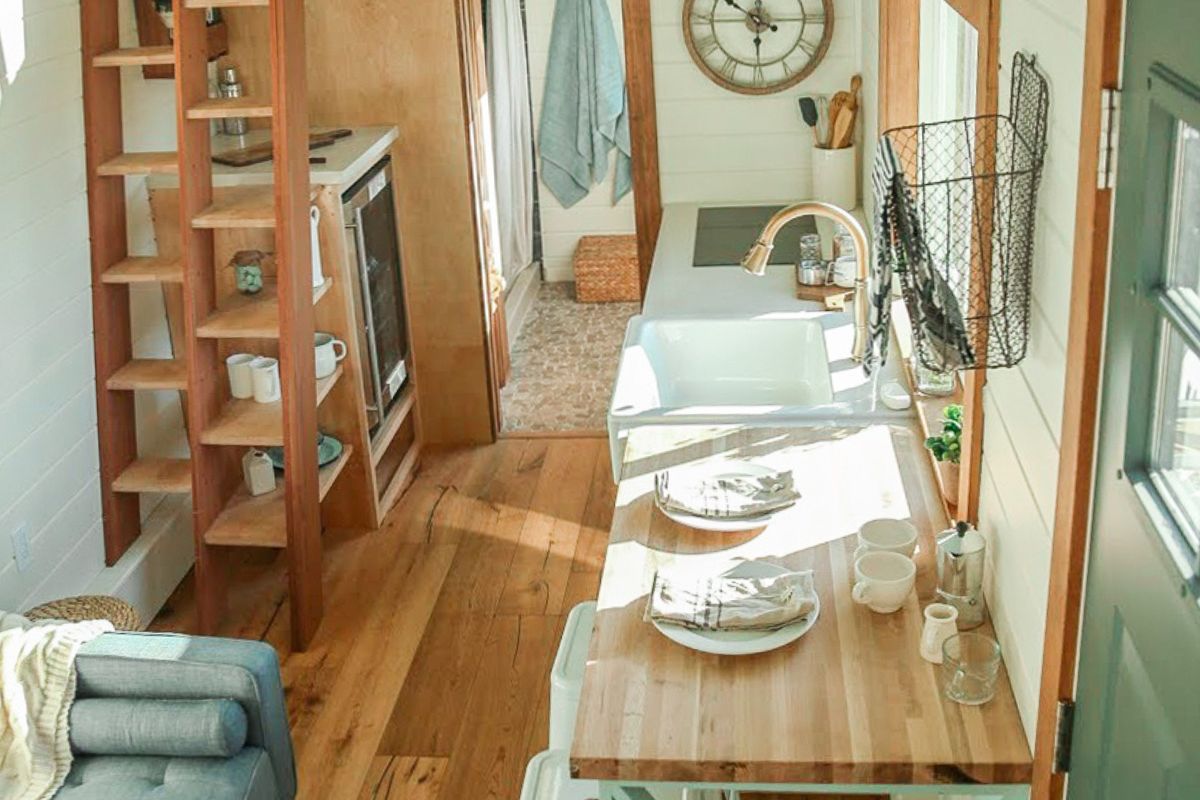Tiny houses might be short on square footage, but they’re big on personality. And when it comes to decorating one, every choice matters. That’s where the magic of mixing styles comes in. One of the boldest (and most fun) pairings? Retro wallpaper and contemporary furniture. If you are new to the concept, it might sound like a clash—the funky vibes of the ’60s and ’70s meeting sleek, modern lines. But trust us, when done right, it’s a total design win.
Retro wallpaper brings color, character, and a dose of nostalgia. It can turn a plain wall into a statement. Pair it with minimalist furniture, and suddenly, your tiny space feels balanced, curated, and uniquely you. It’s all about contrast—the kind that feels intentional and stylish, not chaotic.
So, if you’ve been eyeing that bold print but wondering how it’ll fit with your modern pieces, you’re in the right place. Let’s break down how to mix the two without losing space, style, or sanity.
Understanding Retro Wallpaper
Retro wallpaper is more than just a throwback to decades past. It's a bold statement-maker that brings warmth, color, and character into any space. Drawing inspiration from the '60s, '70s, and '80s, retro wallpaper often features groovy geometrics, earthy florals, bold stripes, and playful shapes. Each pattern tells a story, evoking a time when interiors were unapologetically expressive.
In tiny houses, where every square inch counts, wallpaper becomes a tool to inject style without adding clutter. Whether you’re going for a psychedelic vibe or a muted vintage charm, retro wallpaper adds personality in a way paint often can’t. It’s no surprise homeowners are rediscovering its magic.
Choosing the Right Pattern for a Tiny Home
In compact spaces, selecting the right wallpaper pattern is key. Go too bold, and you risk overwhelming the room. Go too subtle, and it might get lost among your furnishings.
Start by evaluating your space. Rooms with limited natural light tend to benefit from lighter wallpaper with delicate patterns. These designs reflect light and create the illusion of openness. On the other hand, if you have a tiny living room that gets plenty of sunlight, don’t shy away from bolder prints—just keep it to a single feature wall to prevent visual chaos.
Your existing color scheme matters, too. Choose wallpaper that either complements your furniture or introduces a few accent shades. For example, a burnt orange and brown floral print could beautifully offset a sleek white couch while tying in a warm-toned rug.

How to Balance Retro Wallpaper with Contemporary Furniture
At first glance, retro wallpaper and modern furniture might seem like unlikely roommates. But they actually complement each other when done right. The key is restraint.
Start with a focal wall. Let your retro wallpaper take center stage while keeping the remaining walls neutral. From there, bring in streamlined furniture with clean lines and minimalist shapes. Think of mid-century-inspired sofas, Scandinavian dining chairs, or glass coffee tables.
Color plays a role in this harmony, too. If your wallpaper is loud, go for muted furniture upholstery—like gray, cream, or soft leather. This way, the visual interest stays on the wall while the rest of the space feels clean and composed. It’s all about balance: let one element do the talking while the other listens.
Playing with Color & Texture for Harmony
Texture is an underrated player in creating a well-balanced tiny home. Retro wallpaper often features intricate patterns, which can sometimes make a room feel busy. Pairing that with tactile furniture—like velvet cushions, matte metal legs, or woven throws—adds dimension without overloading the senses. These tactile elements ground the space, offering visual rest in contrast to bold prints.
Color coordination is also essential. Pull one or two tones from your wallpaper and echo them subtly through your furniture or accessories. For instance, if your wallpaper has hints of olive green, a sleek olive ottoman or a small planter can carry that color across the room without overdoing it. Even a simple lampshade or artwork can help reinforce the color palette in a subtle, stylish way.
The goal is to create a thread that ties the space together. That way, even if your furniture is brand new and your wallpaper harks back to 1972, the room feels cohesive.
Creating a Focal Point with Retro Wallpaper
Every tiny house benefits from a strong focal point—a visual anchor that helps define the space. Retro wallpaper is perfect for this role. Its patterns instantly draw the eye and set a tone.
Choose one wall to highlight: perhaps the one behind your bed, the couch, or even the kitchen backsplash. Once that decision is made, build around it. Place a low-profile contemporary couch or a minimalist bed frame in front of it. The simplicity of the furniture will amplify the drama of the wallpaper.
This approach not only makes the wallpaper the hero but also prevents the space from feeling too "busy." It's a conversation starter and a backdrop rolled into one. Add a few thoughtfully placed accessories—like a pendant light or framed print—to frame the wall without competing with it.
Accessories that Tie It All Together
Accessories are the secret sauce that can blend retro and modern styles effortlessly. Look for items that echo the era of your wallpaper without feeling kitschy. A brass lamp, a sunburst mirror, or a vintage-inspired radio can do wonders.
Layering textiles like rugs, cushions, and throws is another way to bridge the gap. A mid-century modern chair with a patterned pillow in a similar color to your wallpaper can feel intentional rather than accidental.
Don't forget wall art. Abstract prints, retro posters, or black-and-white photography can break up the wallpaper pattern and add more depth to your walls.
Lighting: The Secret Sauce to Seamless Styling
Lighting isn’t just functional—it’s transformational. In tiny homes especially, lighting sets the tone. Pair your retro wallpaper with sleek, modern lighting fixtures to balance the vibe. Pendant lights with matte finishes or simple metallic sconces keep things clean and elegant.
Consider layering lighting: overhead fixtures for general brightness, task lighting for reading or cooking, and accent lighting to highlight your wallpaper. A strategically placed floor lamp can not only illuminate but also cast dramatic shadows on textured wallpaper, enhancing its charm.
Reflective surfaces also come in handy. Mirrored decor, glass tables, or high-gloss finishes can help bounce light around and make the space feel larger.
Endnote: Embrace the Blend
Mixing retro wallpaper with contemporary furniture isn’t about following strict rules—it’s about curating a space that feels like you. Tiny homes, with their limited space and high visibility, thrive on design choices that tell a story. Retro wallpaper adds warmth, character, and a touch of nostalgia, while modern furniture brings structure and function.
Together, they strike a perfect balance of style and substance. Whether you’re going for boho chic, mid-century glam, or minimalist retro, the trick lies in editing: choose pieces that complement rather than compete. Start small, stay intentional, and don’t be afraid to let your personality peek through. After all, design is less about perfection and more about expression—and blending the old with the new is one of the best ways to do just that.






Share: